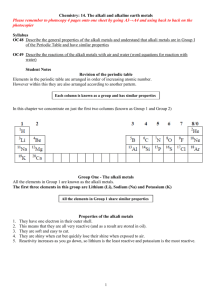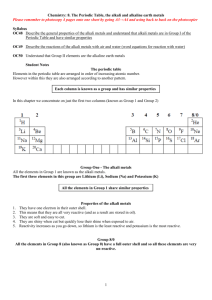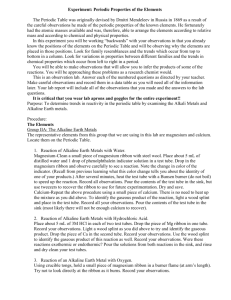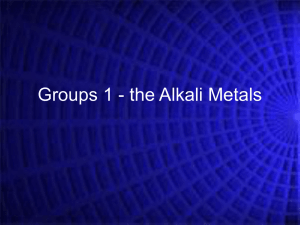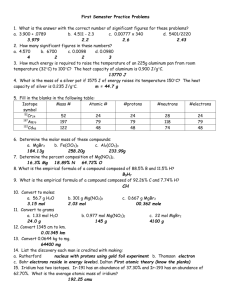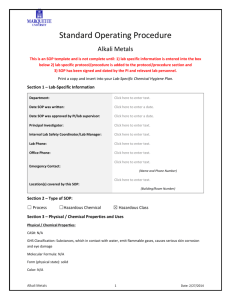14. The alkali and alkaline earth metals
advertisement
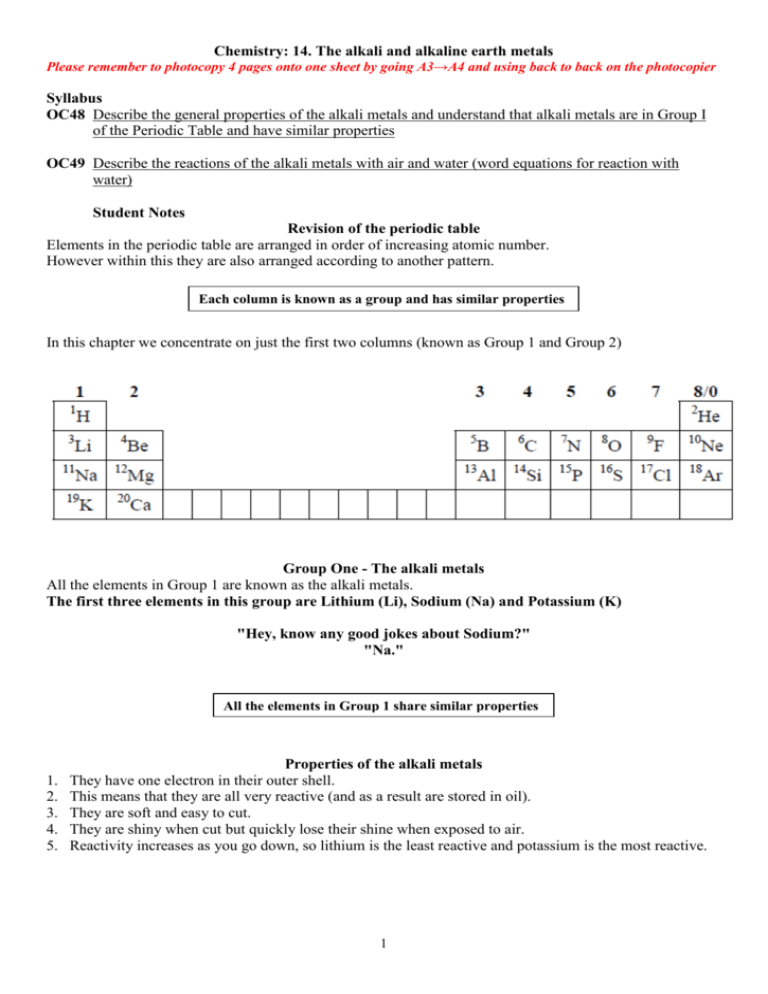
Chemistry: 14. The alkali and alkaline earth metals Please remember to photocopy 4 pages onto one sheet by going A3→A4 and using back to back on the photocopier Syllabus OC48 Describe the general properties of the alkali metals and understand that alkali metals are in Group I of the Periodic Table and have similar properties OC49 Describe the reactions of the alkali metals with air and water (word equations for reaction with water) Student Notes Revision of the periodic table Elements in the periodic table are arranged in order of increasing atomic number. However within this they are also arranged according to another pattern. Each column is known as a group and has similar properties In this chapter we concentrate on just the first two columns (known as Group 1 and Group 2) Group One - The alkali metals All the elements in Group 1 are known as the alkali metals. The first three elements in this group are Lithium (Li), Sodium (Na) and Potassium (K) "Hey, know any good jokes about Sodium?" "Na." All the elements in Group 1 share similar properties 1. 2. 3. 4. 5. Properties of the alkali metals They have one electron in their outer shell. This means that they are all very reactive (and as a result are stored in oil). They are soft and easy to cut. They are shiny when cut but quickly lose their shine when exposed to air. Reactivity increases as you go down, so lithium is the least reactive and potassium is the most reactive. 1 Reactions of the alkali metals with air Alkali metals react with air and quickly lose their shine to form a metal oxide. metal + oxygen lithium lithium + oxygen → lithium oxide 4Li + O2 → 2Li2O → metal oxide sodium sodium + oxygen → sodium oxide 4Na + O2 → 2Na2O Reactions of the alkali metals with water Alkali metals react vigorously with water. When dropped in water they float and fizz around and may even catch fire metal lithium + water + water → lithium → lithium hydroxide + hydrogen metal hydroxide sodium + water + hydrogen sodium → sodium hydroxide + hydrogen Group Two - The alkaline earth metals Group II elements are known as the alkaline earth metals All the elements in Group 2 are known as the alkaline earth metals. The first three elements in this group are beryllium (Be), magnesium (Mg) and calcium (Ca). Group Eight/(Group zero) All the elements in Group 8 (also known as Group 0) have a full outer shell and so all these elements are very un-reactive. The elements in Group 8 are also known as the ‘Nobel gases’ – can you see why? Argon walks into a bar. The barman says “Sorry sir, we don’t serve Nobel Gases here”. Argon doesn’t react. 2 Exam Questions 1. [2007 OL] Complete the following sentence below inserting the correct words from the list on the right. All the known _________________ are listed in the ____________________________. 2. [2007] Give two properties of alkali metals. Atoms Elements Compounds Periodic table 3. [2012] (i) Describe the reaction of a named alkali metal with water. (ii) Name a product of the reaction. 4. [2008] The diagram shows the first twenty elements in their positions in the periodic table. The number given with each element is the atomic number of that element. (i) By what name are group two metals known? (ii) Why are the noble gases, group 8/0, very chemically unreactive? 5. [2011] The diagram is an outline periodic table. One area, a group of elements, is shaded. Name this group of elements and give one chemical property that they have in common. 6. [2006] (i) Show, clearly using shading and labelling, the location of the alkaline earth metals on the blank periodic table given. (ii) Name an alkaline earth metal. 3 Exam Solutions 1. Elements Periodic table 2. Soft (can be cut with a knife), low density(float on water), shiny (lustrous) when cut, tarnish(form oxide) (reacts) with air/ burn in air, coloured flames, react with water, hydrogen produced with water, hydroxides formed with water/, silver’ (white metals), very reactive/ one electron in outer orbit… 3. (i) Lithium (or Sodium, or Potassium) sparks when placed in water. (ii) Lithium Hydroxide (or Sodium Hydroxide, or Potassium Hydroxide) or hydrogen. 4. (i) They are called the alkaline earth metals. (ii) Because their outer orbit (shell) is ‘full’ of electrons. 5. (i) Alkali metals (ii) Very reactive/ react with air / react with water/ produce hydrogen with water/ produce an alkaline solution when they react with water/ catch fire on water/ burn with coloured flame/ form ionic compounds/ one electron in outershell… 6. (i) The second column of table should be shaded and clearly labelled as Group 2 (ii) Beryllium, magnesium, calcium. 4
